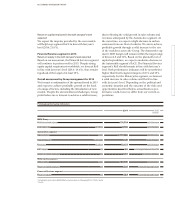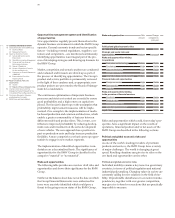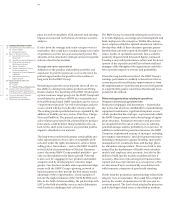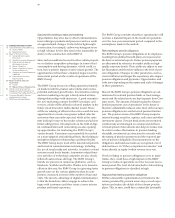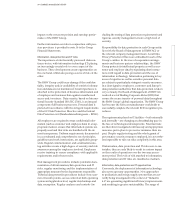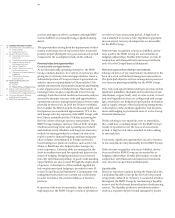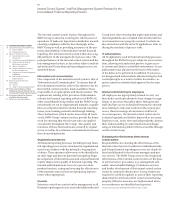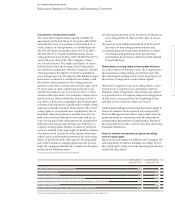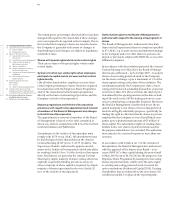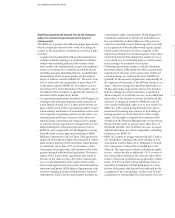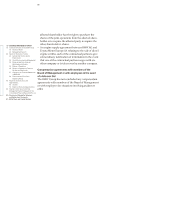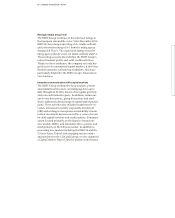BMW 2014 Annual Report Download - page 79
Download and view the complete annual report
Please find page 79 of the 2014 BMW annual report below. You can navigate through the pages in the report by either clicking on the pages listed below, or by using the keyword search tool below to find specific information within the annual report.
79 COMBINED MANAGEMENT REPORT
of cash flow requirements and sourcing forecast sys-
tem
in place throughout the Group. Liquidity risks may
be reflected in rising refinancing costs. They may also
manifest themselves in restricted access to funds as a
consequence of the general market situation or the de-
fault of individual banks. The major part of the Finan-
cial Services segment’s credit financing and lease
busi-
ness is refinanced on capital markets. Thanks to its
excellent creditworthiness, the BMW Group has good
access to financial markets and, as in previous years,
was able to raise funds at good conditions in 2014, re-
flecting a diversified refinancing strategy and the solid
liquidity and earnings base of the BMW Group. Inter-
nationally recognised rating agencies have additionally
confirmed the BMW Group’s solid creditworthiness.
If liquidity risks were to materialise, they are only likely
to result in a low impact on the BMW Group’s results
of operations over the two-year assessment period.
The risk of incurring liquidity risk is classified as low –
including the risk of the BMW Group’s rating being
downgraded and any ensuing deterioration in financing
conditions.
If the relevant recognition criteria are fulfilled,
deriva-
tives used by the BMW Group are accounted for as
hedging relationships. Further information on risks in
conjunction with financial instruments is provided in
note 43 to the Group Financial Statements.
Risks and opportunities relating to Financial Services
The categories of risk relating to the provision of finan-
cial services are credit and counterparty risk, residual
value risk, interest rate risk, liquidity risk and opera-
tional risk. In order to evaluate and manage these risks,
a variety of internal methods has been developed
based
on regulatory environment requirements (such
as Basel III) and which comply with both national and
international standards. A set of strategic principles
and rules derived from regulatory requirements serves
as the basis for risk management within the Financial
Services segment. At the heart of the risk management
process is a clear division between front- and back-of-
fice activities and a comprehensive internal control sys-
tem. The key risk management tool employed
within
the Financial Services segment is aimed at ensuring
that the Group’s risk-bearing capacity is not exceeded.
In this context, all risks (defined as “unexpected losses”)
must be covered at all times by an appropriate asset
cushion in the form of equity capital. Unexpected losses
are measured using a variety of value-at-risk techniques,
adapted to each relevant risk category. Risks are aggre-
gated after taking account of correlation effects. The
total amount of risks calculated in this way is then com-
pared with the resources available to cover risks (asset
cushion). The segment’s risk-bearing capacity is moni-
tored
continuously with the aid of an integrated limit
system which also differentiates between the various risk
categories. The segment’s total risk exposure was
covered at all times during the past year by the available
risk-coverage volumes.
Credit and counterparty risks and opportunities
Credit and counterparty default risk arises within the
Financial Services segment if a contractual partner (i. e.
a customer or dealer) either becomes unable or is only
partially able to fulfil its contractual obligations, such
that lower income is generated or losses incurred. The
Financial Services segment uses a variety of rating
systems in order to assess the creditworthiness of its
contractual partners. Credit risks are managed at the
time of the initial credit decision on the basis of a calcu-
lation of the present value of standard risk costs and
subsequently, during the term of the credit, by using a
range of risk provisioning techniques to cover risks
emanating from changes in customer creditworthiness.
In this context, individual customers are classified by
category each month on the basis of their current con-
tractual status, and appropriate levels of allowance
recognised in accordance with that classification. If
economies develop more favourably than assumed in
the outlook, there is a chance that credit losses may be
reduced and earnings improved accordingly.
If credit and counterparty risks were to materialise, they
could have a medium impact on the BMW
Group’s
results of operations over the two-year assessment pe-
riod.
The level of risk attached to credit and counter-
party risks is classified as high. The BMW Group classi-
fies potential opportunities in this area as material.
Residual value risks and opportunities
Risks and opportunities arise at the end of the contrac-
tual term of a lease if the market value of the leased vehi-
cle differs from the residual value calculated at the
in-
ception of the lease and factored into the lease payments.


